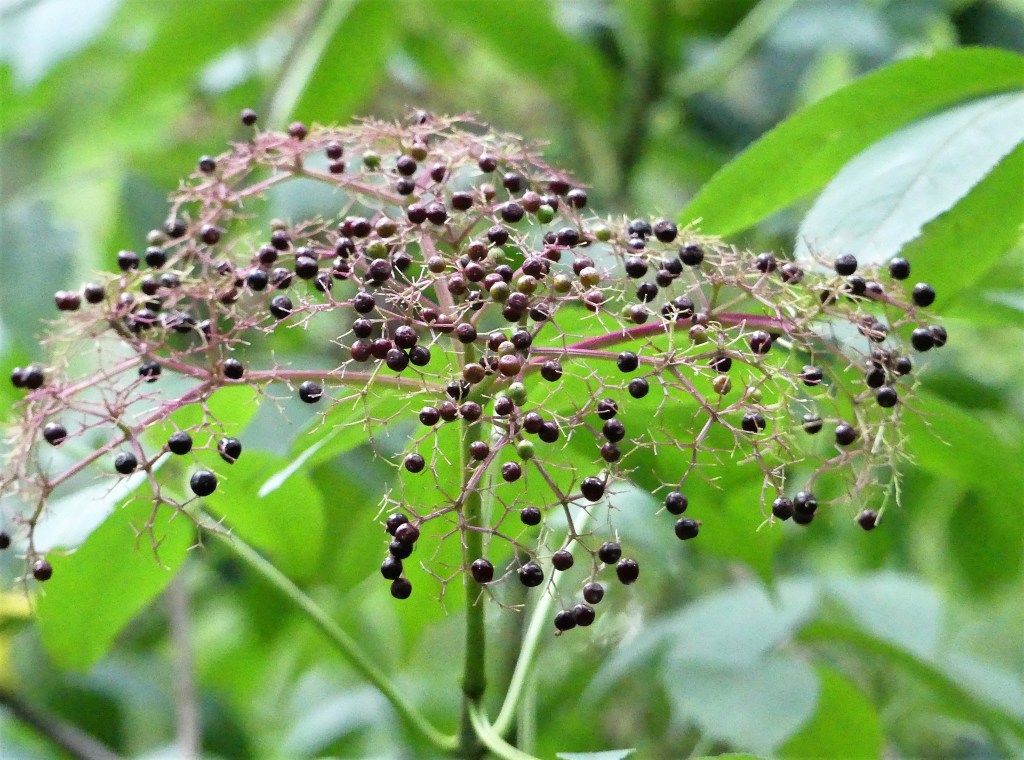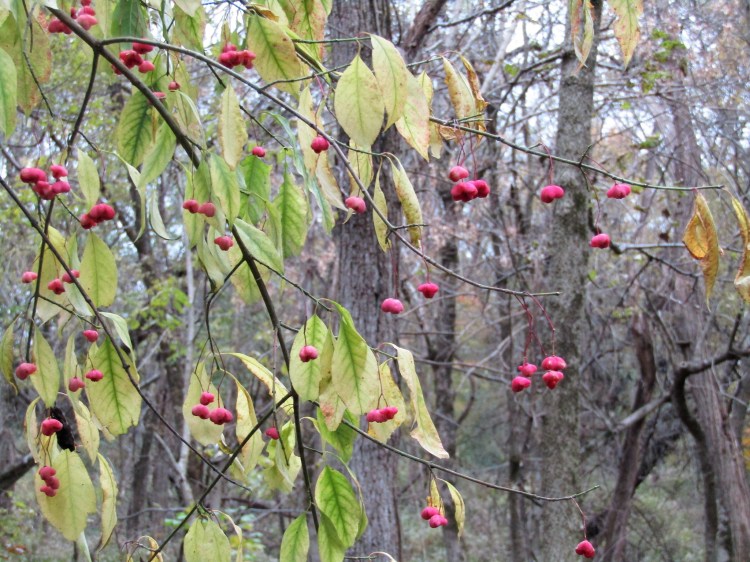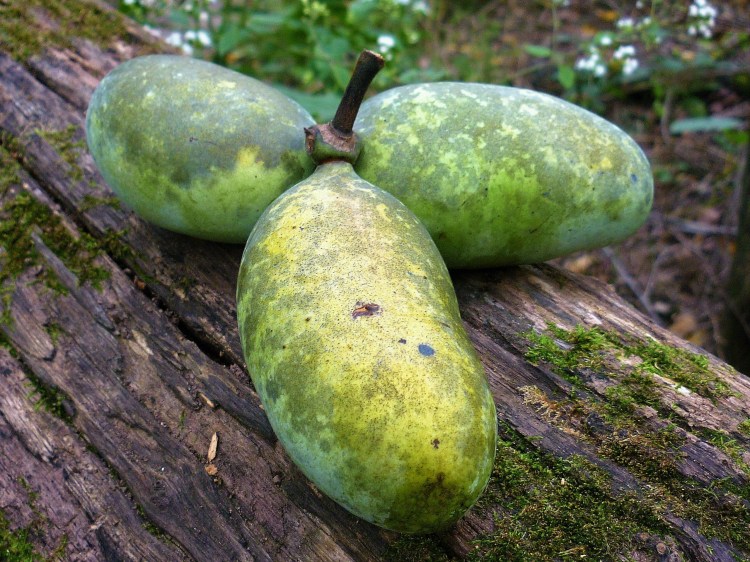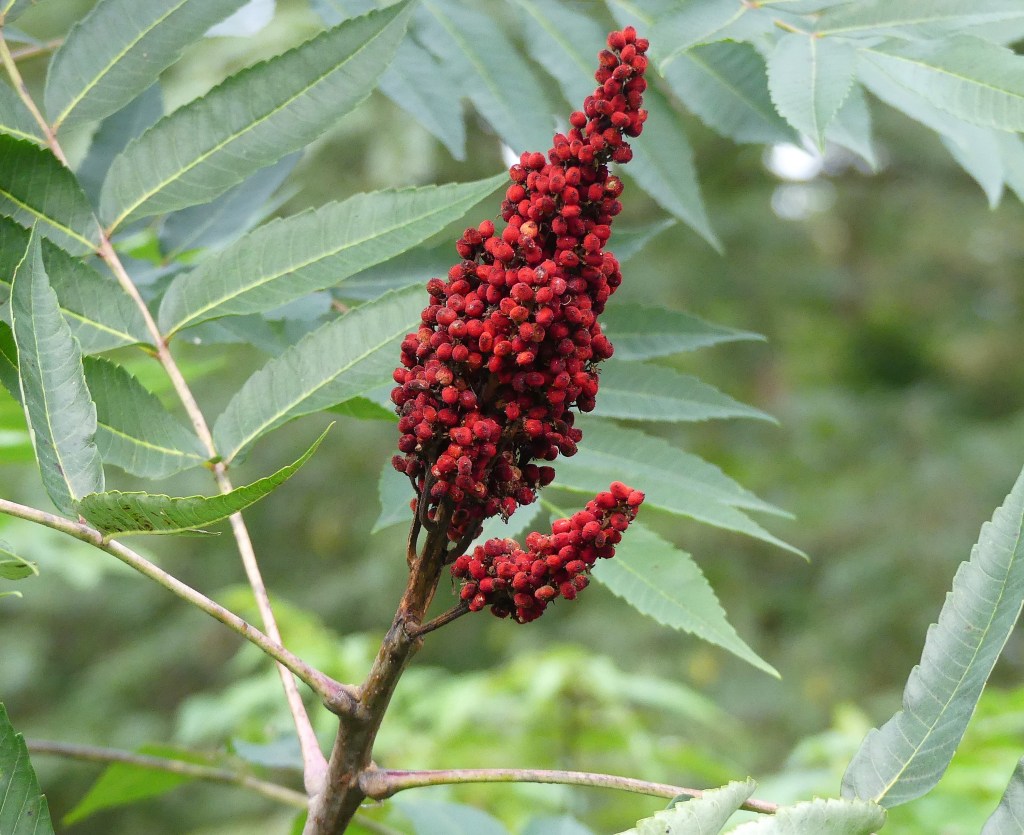
Perhaps the word “forest” should be a verb, not a noun. From the first tiny Black locust trees pioneering an old field, to a centuries old Sugar maple and Beech forest, there is continual change. Disturbance of course accelerates the process, and this little forest has been changing on the fast track over the past ten years, thanks to invasive plant removal and the Emerald ash borer.

Both the canopy and understory layers have been opened up to sunlight in a very short time, leading to an explosion of fast growing opportunists like Pokeweed. This tall, widely branching perennial is a huge berry producer, at this season dangling its wares over the trail at head height – nourishment for frugivorous birds, turkeys, mice, deer, coyotes, box turtles and many more.

In contrast to Pokeweed, many forest fruits are borne on shrubs and vines. Though we tend to think of forests as mostly composed of trees, the eastern forest understory is home to quite a few shrubby, berry producing species that depend largely on birds for dispersal. Some, like the ubiquitous blackberries, raspberries and grapevines, establish on edges and early successional sites with lots of sunlight. But in this forest, interior light filled gaps resulting from invasive shrub removal and dying ash trees are also filling with fruiting species like Pawpaw, Spicebush, Elderberry, Wahoo, Coralberry and Greenbriar.
This new openness is both an opportunity for understory revival and a challenge. Urban forest management in particular is complicated by the presence of so many woody and climbing invasive plants. The ongoing task is to keep the understory revival on track by planting where needed, and carefully monitoring and removing the faster growing non-native woody species that could easily overwhelm the recovery.

I think of invasive plant management as a replacement program. The non-native shrubs and vines that took over the understory of this little forest did so by producing massive amounts of berries, and letting the birds do the rest. Undoubtedly these plants provided food and habitat for frugivorous birds and other animals. But they also created a species monoculture and dense shade that excluded most native plants. Thanks to the forest steward’s intensive work over the past decade, the berries of invasive Bush honeysuckle, Privet and Wintercreeper – once providing over 90% of forest fruit – are now in very short supply. Yesterday I enjoyed watching a mob of robins fill up on the first ripening Spicebush berries, and it was gratifying to know they were dispersing a keystone native shrub!

Timing helps explain the great diversity of fruiting plants in eastern forests. If a plant’s fruit is ripe at a season when little else is available, chances of disperal are better. Though forest fruit season peaks in late summer and fall, there is a progression of ripening berries beginning in early summer with Red mulberry and Red x White mulberry hybrids.

This first fruit is heralded by noisy, joyous flocks of robins and Cedar waxwings converging on the berry laden trees. I have stood beneath such a tree with bits of berries and bird droppings splattering down around me!

Black elderberry fruits are the next to ripen, following pollination of the broad flat-topped corymbs of tiny white flowers. Like other berry producers, this plant provides twice – nectar and pollen for insects, and fruits for birds, mammals and box turtles.

Midsummer brings the bramble fruits Black raspberries and blackberries, mostly on the forest edge but also in sunny gaps.

Though in the same genus, Cornus, shrubby dogwoods are less well known than their lovely cousin, the understory tree Flowering dogwood. These thicket forming species with late summer ripening white or blue berries include Gray, Silky, Red osier, and Roughleaf dogwoods. If protected from heavy deer browsing, the dense thickets provide great habitat for migrating frugivores like thrushes, Gray catbirds and Brown thrashers.

Early fall brings another red berry besides Spicebush, the somewhat uncommon Wahoo, or Eastern burning bush (Euonymus atropupureus). As one of the common names suggests, it’s closely related to the non-native, invasive Burning bush (Euonymus alatus) so often planted for its red fall foliage. Wahoo would likely be more common in this forest, but for the fact that deer browse it heavily (most Euonymus are highly deer preferred).


Some forest fruits are seldom noticed since they’re borne on vines high up in the canopy, and only seen when they fall to the ground. Wild grapes are easy to recognize, but the fruits of vines like Virginia creeper, Poison ivy and Greenbriar (Smilax spp.) are less well known and equally important to wildlife.


Even on the forest floor, fruits can be found – Mayapple, Jack in the Pulpit, and its close relative Green dragon are all becoming more abundant since they’re shunned by deer.

The largest native fruit in North America is the Pawpaw, which grows on a tree of the same name, the only member of the tropical family Annonaceae found in eastern forests. It’s abundant in this forest and becoming one of the main understory trees. Though delicious to humans and other animals, the two to three inch banana-like fruit with large seeds may be an anachronism in ecological terms. Large fruits growing in places where large animals are now extinct (think mammoths, giant sloths) are likely not getting dispersed in the manner orginally intended. Rather than ingesting the whole fruit and depositing its seeds in a nice pile of poop, smaller mammals tend to nibble them and ingest fewer seeds. But not to worry,it only takes one seed to start an entire clonal Pawpaw patch!(Pawpaws are ripening now and can be found on the ground under large “patches”).
The much smaller Persimmon tree fruits fare better with mammal dispersal; though the tree is uncommon in this forest, I notice the seeds in fox and coyote scats in late fall.

Sumac berries are among the last fruits of the year. The dense clusters at the end of branches will persist through the winter, providing food for birds when little else is available. For this reason, and the valuable cover they provide, the forest stewards have been planting Shining sumac, since sumac patches no longer existed at the forest edges. The fruit in the pic above is part of the first crop produced by a patch we planted two years ago. Now well established, the original plants are taller than me, and the patch will spread clonally over time. When restoration plantings succeed this well, I feel hugely rewarded for all the hard work!
Ginny
It’s been amazing to watch the transformation at the LNC! Your hard work is definitely paying off!! Thanks for compiling seasonal fruiting info. Nice to have all in one place!
LikeLiked by 1 person
oneforestfragment
Thanks Ginny – the forest stewards are equally amazed! Once we got the revival started, it seems to spread faster each year.
LikeLike
debbie utz
Fascinating, you always give me something to notice on my next walk at LNC.
LikeLiked by 1 person
tanjabrittonwriter
What an astonishing bounty. Your report reminds me why I want to plant more native, berry-bearing plants. It’s a win-win situation for everybody involved: pollinators, birds, humans, and the entire ecosystem.
LikeLiked by 1 person
Jim Sky
Wonderful! Ordered some spice bushes, can’t wait to get them planted. I really want a mulberry tree. I had one for years in my yard at another house. The berries were so good, and complimented the blue in my old car nicely. My kids loved to eat them. But people get bent out of shape because of the purple bird poop issue.
I checked into getting a project going on iNaturalist for the BCNP and was encouraged to just set it up as a “location”. I did that and now you get all of the iNaturalist observations that have ever been made there by going to:
https://www.inaturalist.org/observations?place_id=157435
There are over 250 observations of 153 species so far.
LikeLiked by 1 person
oneforestfragment
Thanks for that Jim, I’m inspired to add observations now! I take many pictures, but have been less motivated to do anything with them.
The problem with getting a mulberry tree, (besides the berry poop mess) is making sure it’s a good one. I believe the one tree growing at the trailhead behind the LNC is a Red mulberry cultivar, since it’s berries are larger than I’ve seen on wild Red mulberry. The hybrids Red x White pop up everywhere and though they produce lots of berries, they’re small and low on flavor.
LikeLike
Jim Sky
So the mulberry trees I see popping up out of the ground next to every chain linked fence are not to be trusted? It never even occurred to me that there was more than one type of mulberry tree. Ignorance is bliss until try to interact with the world. I better read up on this. Thanks
iNaturalist has turned into my main social media, I suppose. I check for new Jefferson County observations of any type and follow fishes from the entire state. For amateur naturalists like me, who do not have a wide range of taxonomic knowledge, it is a fun way to learn about anything living thing that catches your interest. For BCSNP, I think it might be valuable to promote observations from there. A species list gathered by many visitors might be a nice thing to have when you go for funding.
LikeLiked by 1 person
oneforestfragment
I agree about promoting inaturalist. You should contact the LNC, and I will too. Perhaps a link on the website and mention on the facebook page? I will also promote it on my blog, and could add a link there.
LikeLike
tonytomeo
WOW! So enviable. Several of these inhabit huge ranges of North America, but not here. When pokeweed showed up, there was concern that it would be invasive. It was, but there is nothing we can do about it now. It does not seem to be too aggressive. It makes good ink. We have our own versions of blackberry, raspberry and elderberry. I recently acquired pawpaw and persimmon, and will be growing mulberry and muscadine.
LikeLiked by 1 person
oneforestfragment
Well, Pokeweed is an aggressive native here too. I don’t mind because it fills an open, disturbed niche that would just get full of worse plants like poison hemlock, etc, etc.
We have a relatively species-rich forest type, as it’s believed to have developed from the ancient, highly diverse “Mixed Mesophytic” forest type of the Appalachians described by E. Lucy Braun.
LikeLiked by 1 person
tonytomeo
I would not mind pokeweed if it were native. It concerns me because it is exotic.
LikeLike
shoreacres
I laughed at the comments about the mulberry. All I can think about are the hours I’ve spent scrubbing those stains off the white fiberglass of boats that I work on. Between the grackles and starlings sitting in the rigging with their mulberry-laden poo, and the ospreys dropping fish entrails from the top of the masts, I’m occasionally a bit fussy when it comes to nature!
But I love seeing these fruits. This weekend, I came across beautyberry and coral bean seeds. The palmettos are one of our first to fruit, and I’ve noticed that birds have been noshing on them already. I always enjoy finding ripened wolfberries shining in the marshes, too. They’re a primary food source for whooping cranes when they first arrive down here, and I’ve always thought of them as one of our best “fall colors.”
LikeLiked by 1 person
oneforestfragment
You have great berries there! I love Beautyberry but don’t plant it since I’m not sure it occurs naturally here. Wolfberry is new to me – such gorgeous edible berries and in the nightshade family!
LikeLiked by 1 person